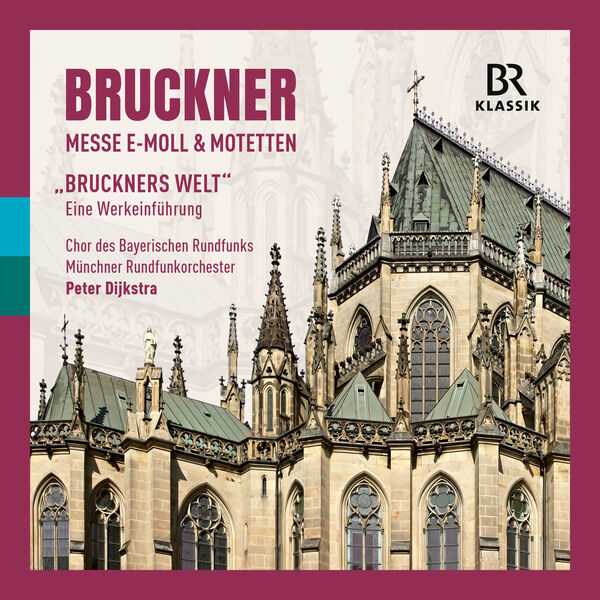

Composer: Anton Bruckner
Orchestra: Münchner Rundfunkorchester
Conductor: Peter Dijkstra
Format: FLAC (tracks)
Label: BR Klassik
Catalogue: 900940
Release: 2024
Size: 1.59 GB
Recovery: +3%
Scan: yes
01. Ave Maria, WAB 6
02. Locus iste, WAB 23
Mass No. 2 in E Minor, WAB 27 (1882 Version)
03. I. Kyrie
04. II. Gloria
05. III. Credo
06. IV. Sanctus
07. V. Benedictus
08. VI. Agnus Dei
09. Virga Jesse, WAB 52
10. Aequale, WAB 114
11. Os justi, WAB 30
12. Aequale, WAB 149
13. Christus factus est, WAB 11
Bruckner’s Welt
14. Kapitel 1: Kyrie
15. Kapitel 1: Kirchenmusik im wuerdigen Style
16. Kapitel 1: Der verlaesterte Herr Bruckner
17. Kapitel 1: Heimat und Herkunft
18. Kapitel 1: Lehramtsgehilfe für Trivialschulen
19. Kapitel 2: Das glueckliche Naturtalent
20. Kapitel 2: Restaurierungsarbeiten
21. Kapitel 2: Domine Deus, Agnus Dei, Filius patris
22. Kapitel 2: Bruckner wird Student
23. Kapitel 3: Chormeister Bruckner
24. Kapitel 3: Davids Harfe und Koenig Saul
25. Kapitel 3: Die Dombaustelle
26. Kapitel 3: Du schwaermst wieder mal fuer eine!
27. Kapitel 3: Der herrlichste meiner Lebenstage
In addition to his symphonies, Anton Bruckner is best known for his sacred works: his stirring masses and his deeply moving a cappella motets. On this new BR-KLASSIK CD, to mark the Bruckner Year 2024, the Bavarian Radio Chorus and the Münchner Rundfunkorchester conducted by Peter Dijkstra present his Mass No. 2 together with five well-known motets and the two short Aequali for three trombones from 1847. The new studio recordings were made in connection with the opening concert of the 2023/24 season on October 28, 2023. On a second CD, “Bruckner’s World” by Markus Vanhoefer offers not only an introduction to the recorded works but also a detailed description of the life and work of this important Late Romantic composer. After Bruckner’s uncommissioned Mass (No. 1) in D minor had brought him to the attention of a wider public – following its premiere on November 20, 1864 in the Old Cathedral in Linz and a repeat performance in the city’s Redoutensaal – Bishop Franz Joseph Rudigier commissioned a second mass from the composer. Bruckner wrote the work between August and November 1866, and it was to be premiered at the consecration of the Votive Chapel of the New Cathedral; due to delays in the construction work, however, the performance could not take place until September 29, 1869. The premiere of the Mass (No. 2) in E minor for eight-part mixed choir and wind ensemble was also a great success, and Bruckner described it as “the most glorious day” of his life. The unusual instrumentation was due to the occasion and the open-air performance venue on the cathedral building site (the new chapel had proven too small for the choir). The work derives its particular tension from the sharp contrasts between archaic, psalm-like monophony and a strictly polyphonic movement structure modelled on Palestrina, combined with the “modern” wind accompaniment in sweeping, romantic harmony. Bruckner thoroughly revised the Mass (No. 2) between 1876 and 1882, and the premiere of the second version in the Old Cathedral on October 4, 1885, as part of the Diocesan Jubilee in Linz, was once again an outstanding success. The composer “stood at the organ during the performance and gazed rapturously at the vault of the cathedral, his lips moving in silent prayer.” Bruckner’s sacred motets are characterised by Catholic worship and the church spaces that were Bruckner’s home from childhood. In 1837, at the age of 13, he was admitted as a choirboy to the Augustinian canons’ monastery of Sankt Florian near Linz, where he worked as an organist from 1848 to 1855. His religious devotion and early influence meant that he initially saw himself as a church musician, before broadening his scope to include symphonic music – in whose sound architecture the organ also found an audible echo.